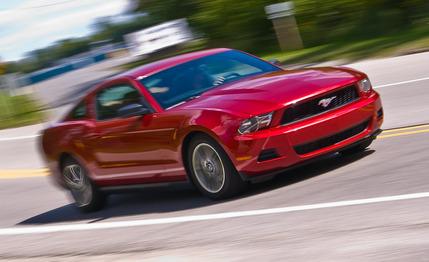
 Short Take Road Test
Short Take Road Test
The 2010 Mustang GT is better than ever because it had to be. But competition for the V-6 Stang is also intensifying, so we set out to determine if the V-6 similarly leads the herd.


Entry-level Mustangs start at $21,845, which undercuts the V-6 rear-drive coupes from Chevrolet, Dodge, and Hyundai, as well as comparable front-drive two-doors such as the Honda Accord and Nissan Altima. But we upgraded to the V-6 Premium steed, which adds $3000 to the sticker and 17-inch wheels, leather seating and steering wheel, aluminum pedals, and upgraded audio to the options sheet. Mix in $300 for the Red Candy metallic paint and $395 for the Security package—wheel locks and an alarm—and our Mustang V-6 rang up at $25,540.
A Comfortable Cruiser and Quiet, Too
If you’re not driving a Mustang GT, odds are you aren’t driving a Mustang for all-out fun. Whereas last year’s Bullitt suspension and tuning forms the basis for the 2010 GT, V-6 Mustangs carry on with a more relaxed setup. It’s ideal for freeway slogs, where the cushy ride keeps occupants isolated from most road imperfections, although abrupt bumps punch through the soft springs and deliver a solid jolt to the structure. As an added bonus, the high-frequency resonance emitted by the GT’s V-8 at highway speeds is absent with the V-6, making for more serene cruising.


Although 210 hp isn’t much, neither is the V-6 Mustang’s 3421-pound curb weight. Acceleration is decent, at 6.6 seconds to 60 mph and the quarter-mile in 15.3 at 93 mph, but in a recent comparison test of the V-6 Hyundai Genesis and Chevrolet Camaro, both beat the Mustang through the quarter by about a second. And the Genesis’s base turbocharged inline-four matches the horsepower number of the Mustang’s six.
Around town, the Mustang’s tall gearing minimizes shifting, which is good because the five-speed manual is as satisfying as a lukewarm pile of Kraft Easy Mac. If you’re buying a V-6 Mustang, get the auto. At even 30 mph, anything higher than third lugs the engine. We’d guess the reason is fuel economy—the EPA rates it at 18 city/26 highway, and our observed 19 mpg matches our comparo Camaro and trails the Genesis by 1 mpg.
No Steeplechaser
Venture onto your favorite back road, though, and the V-6 Mustang is as disappointing as Hootie and the Blowfish's sophomore album. It feels as though the suspension bushings are made from the stuff inside Stretch Armstrong, and a heavy foot on the brake pedal induces extreme dive, which might be useful in the winter if drivers hope to employ their Mustang’s front valance as a snow plow. Stops of 182 feet from 70 mph trail not only the Camaro and Genesis but also all four competitors in our recent mid-size hybrid-sedan comparo.
Although the steering is quick and direct, feedback through the wheel is a solid zilch. Still, even with the Deadliest Catch–grade rolling and pitching, the car is surprisingly balanced, with the slightest understeer on turn-in. The six lacks the gusto for power-on oversteer, but the throttle can dial the initial understeer into neutrality, and we herded the Ford around the skidpad for 0.85 g. That trails the stick we got out of the V-6 Camaro and Genesis by a marginal amount (0.02 g and 0.03 g, respectively), but the difference in feel is vastly more pronounced. The Mustang just doesn’t raise the pulse.
That’s the problem with Ford’s pony car. There are a lot of reasons people buy cars, but when it comes to coupes, there are really only two—style and fun—and both are emotional. The Camaro looks worlds better in our opinion, and it and the Genesis are more fun to drive. But rumor has the 2011 Mustang getting a vastly more powerful version of one of Ford’s newer V-6s, and that—mixed with a little more body control—would put the six-pot Mustang right on par with all threats, foreign and domestic.